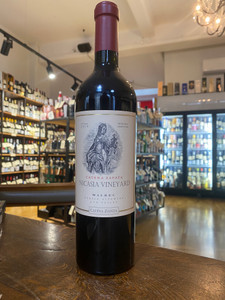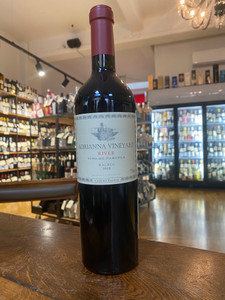
WINE DESCRIPTION
No matter what the vintage, this wine is really more than 100 years old. It represents a family's journey to produce an Argentine Malbec that can stand with the great wines of the world.
VINIFICATION
This wine goes through an extensive cold maceration (10 - 30% Whole Cluster) of 2-10 days at less than 50ºF (10ºC) to extract aromas. The juice is then fermented for around 17-28 days with a total maceration of approximately 25-38 days. Elevage: 15-18 months in French Oak barrel. First, second and third use barrels.
TEN CENTURIES OF LIFE, DEATH AND REBIRTH:
The epic tale of the noble Malbec grape is like no other, and the label for Catena Zapata Malbec Argentino pays tribute to the variety’s history in France and its rise in Argentina. Four female figures embody different landmarks in the history of the grape. Eleanor of Aquitaine represents the birth of Malbec. She is a strong, Old World presence, lingering at the bridge in Cahors, where Malbec came into its own. Next, the Immigrant symbolizes the movement to the New Word and the unknown explorers and adventurers who connected Europe with the Americas. Phylloxera personifies the death of Malbec in the Old World, which enabled its rebirth in the new. Finally, there is Bodega Catena Zapata, represented by Adrianna Catena, who depicts birth, earth and motherhood, sharing the riches of the New World. Today, the Catena family’s fourth generation leads the high-altitude renaissance in Argentina. We are returning Malbec to the sky... where it belongs.
No matter what the vintage, this wine is really more than 100 years old. It represents a family’s journey to produce an Argentine Malbec that can stand with the great wines of the world.
Rebirth of Malbec video - https://youtu.be/ae7sg7kFX40
-
VINEYARDS
Old Vines from the Catena Zapata Family Vineyards, Nicasia and Angélica. The origins of the vines, which we call “The Catena Cuttings”, is a pre-phylloxeric Massale Selection from the Angélica Vineyard.
Harvest time varies depending on each lot's soil composition. Harvest time can vary by several weeks between one lot and another within the same vineyard.
- Nicasia Vineyard: Named after Nicolás Catena Zapata’s grandmother.
- Shallow loamy soil. Gravel on surface and topsoil.
- Location: La Consulta District, San Carlos Region, Mendoza, Argentina.
- Altitude: 3,593 ft (1,095 m) elevation.
- Planted in 1996 (20 years old vineyard).
- Angélica Vineyard: Named after Nicolás Catena Zapata’s mother.
- Soil: Adjacent to dry river bed. Light gravel, loam and clay.
- Location: Lunlunta District, Maipú Region, Mendoza, Argentina.
- Altitude: 3,018 ft (920 m) elevation.
- Planted in: Circa 1930 (90 years old vineyard)
The Producer
"Nicolás Catena Zapata is justly credited with putting Argentinean wines on the world map—by the best expedient of focusing entirely on quality. It's great to know he has started a wine dynasty, too."
Jancis Robinson, Financial Times wine journalist
"Nicolás Catena Zapata is a man of vision, of high intellect, always curious about others and about how the world is developing. He has been instrumental in changing the Argentinian wine scene more than anybody else, pushing it towards high quality."Baron Eric de Rothschild, Château Lafite
When the Catenas decided to experiment with a new terroir at high altitude, they entered a world dominated by the long-held French theory that quality depends mostly on terroir. According to the French, the human factor—whether the winemaker or the vineyard manager—is inconsequential. Quality only depends on nature, climate, and the type of soil where the vineyard is planted. There is nothing that the winemaker can do if the quality does not come from the place where the vineyard is located: the terroir.
In trying to implement this French theory in Argentina several years ago, the Catenas made a startling discovery: The alluvial soils from Mendoza are not homogenous. In other words, in the same vineyard, within short distances, there are both physical and chemical soil differences, resulting in vineyard lots or parcelas with unique characteristics. As a result, each vineyard lot gives origin to its own unique wine with very specific flavors and aromas. This discovery prompted the family to drill down even deeper into the theory of terroir.

Dr. Laura Catena, a biologist who graduated with honors from Harvard University, decided to instill in the winery team the method of research and study, what she calls "the science of understanding nature."
With the help of Catena's Head Winemaker Alejandro Vigil, Fernando Buscema, Catena Institute of Wine Director, and Vineyard Manager Luis Reginato, Laura created the Catena Institute of Wine. Since then, the Catenas have conducted strong research aimed at getting a better understanding of the Argentine terroir, the characteristics of Mendoza, and to study every aspect of their vineyards with the ultimate goal of making Argentine wines that can stand with the best of the world. The Catena's first successful project using research as a guide was with Chardonnay.





